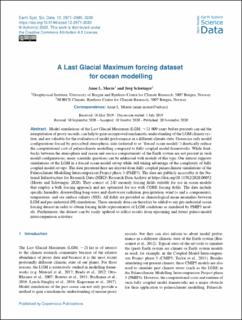| dc.contributor.author | Morée, Anne | |
| dc.contributor.author | Schwinger, Jörg | |
| dc.date.accessioned | 2021-03-08T14:38:54Z | |
| dc.date.available | 2021-03-08T14:38:54Z | |
| dc.date.created | 2020-11-25T13:35:30Z | |
| dc.date.issued | 2020 | |
| dc.identifier.issn | 1866-3508 | |
| dc.identifier.uri | https://hdl.handle.net/11250/2732239 | |
| dc.description.abstract | Model simulations of the Last Glacial Maximum (LGM; ∼ 21 000 years before present) can aid the interpretation of proxy records, can help to gain an improved mechanistic understanding of the LGM climate system, and are valuable for the evaluation of model performance in a different climate state. Ocean-ice only model configurations forced by prescribed atmospheric data (referred to as “forced ocean models”) drastically reduce the computational cost of palaeoclimate modelling compared to fully coupled model frameworks. While feedbacks between the atmosphere and ocean and sea-ice compartments of the Earth system are not present in such model configurations, many scientific questions can be addressed with models of this type. Our dataset supports simulations of the LGM in a forced ocean model set-up while still taking advantage of the complexity of fully coupled model set-ups. The data presented here are derived from fully coupled palaeoclimate simulations of the Palaeoclimate Modelling Intercomparison Project phase 3 (PMIP3). The data are publicly accessible at the National Infrastructure for Research Data (NIRD) Research Data Archive at https://doi.org/10.11582/2020.00052 (Morée and Schwinger, 2020). They consist of 2-D anomaly forcing fields suitable for use in ocean models that employ a bulk forcing approach and are optimized for use with CORE forcing fields. The data include specific humidity, downwelling long-wave and short-wave radiation, precipitation, wind (v and u components), temperature, and sea surface salinity (SSS). All fields are provided as climatological mean anomalies between LGM and pre-industrial (PI) simulations. These anomaly data can therefore be added to any pre-industrial ocean forcing dataset in order to obtain forcing fields representative of LGM conditions as simulated by PMIP3 models. Furthermore, the dataset can be easily updated to reflect results from upcoming and future palaeo-model intercomparison activities. | |
| dc.language.iso | eng | |
| dc.relation.uri | https://essd.copernicus.org/articles/12/2971/2020/essd-12-2971-2020.html | |
| dc.rights | CC BY 4.0 | |
| dc.rights.uri | https://creativecommons.org/licenses/by/4.0/ | |
| dc.title | A Last Glacial Maximum forcing dataset for ocean modelling | |
| dc.type | Peer reviewed | |
| dc.type | Journal article | |
| dc.rights.holder | © 2020, Authors | |
| dc.description.version | publishedVersion | |
| cristin.ispublished | true | |
| cristin.fulltext | original | |
| cristin.qualitycode | 1 | |
| dc.identifier.doi | 10.5194/essd-12-2971-2020 | |
| dc.identifier.cristin | 1852237 | |
| dc.source.journal | Earth System Science Data | |
| dc.source.volume | 12 | |
| dc.source.issue | 4 | |
| dc.relation.project | Norges forskningsråd: 270061 | |
| dc.relation.project | EC/H2020/641816 | |
| dc.relation.project | Norges forskningsråd: ns2980k | |
| dc.relation.project | Notur/NorStore: ns2980k | |
| dc.relation.project | Notur/NorStore: nn2980k | |

